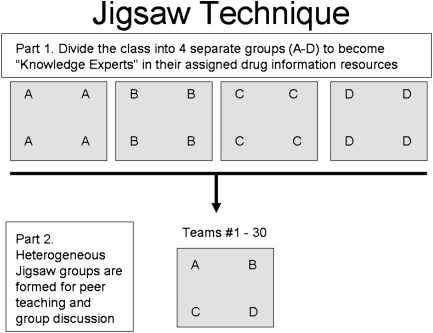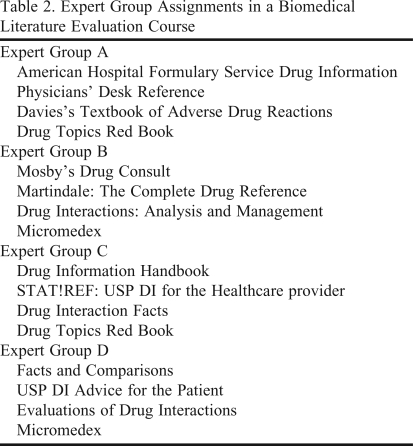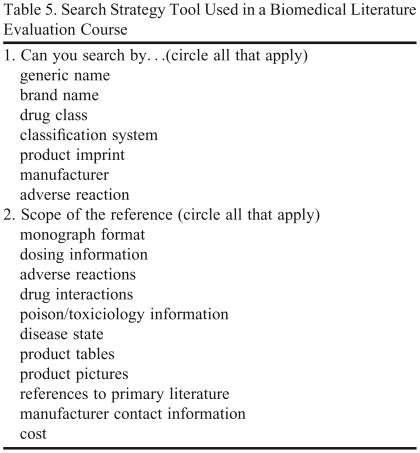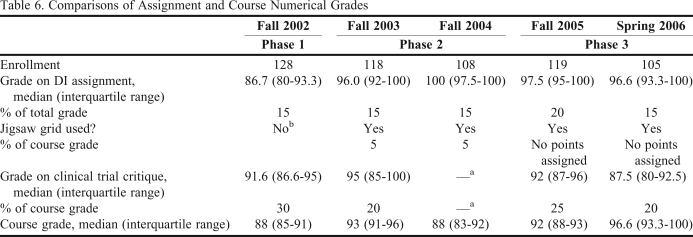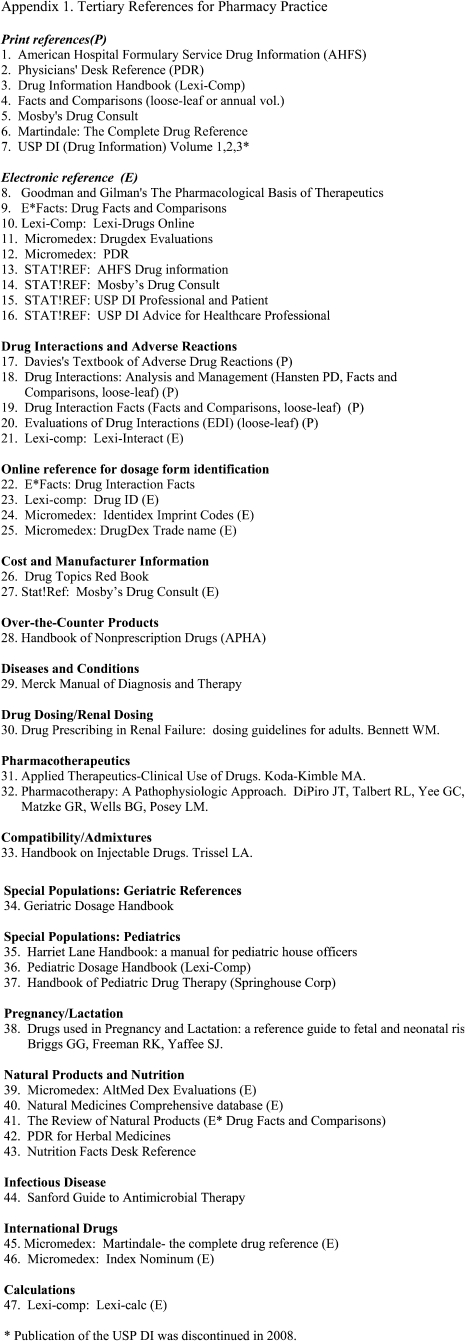Abstract
Objectives
To implement a cooperative learning activity to engage students in analyzing tertiary drug information resources in a literature evaluation course.
Design
The class was divided into 4 sections to form expert groups and each group researched a different set of references using the jigsaw technique. Each member of each expert group was reassigned to a jigsaw group so that each new group was composed of 4 students from 4 different expert groups. The jigsaw groups met to discuss search strategies and rate the usefulness of the references. In addition to group-based learning, teaching methods included students' writing an independent research paper to enhance their abilities to search and analyze drug information resources.
Assessment
The assignment and final course grades improved after implementation of the activity. Students agreed that class discussions were a useful learning experience and 75% (77/102) said they would use the drug information references for other courses.
Conclusion
The jigsaw technique was successful in engaging students in cooperative learning to improve critical thinking skills regarding drug information.
Keywords: active teaching, cooperative learning, jigsaw technique, drug information
INTRODUCTION
As healthcare professionals, pharmacists are often decision makers in settings ranging from patient care to managed care and often consult the literature to determine, for example, current practice guidelines or drug interactions or dosing. Information literacy and applied literature evaluation are fundamental components of the doctor of pharmacy (PharmD) curriculum.1 Students should be capable of conducting systematic searches using medical or health references to formulate responses to drug information questions. The curriculum should aim to instill students with the ability to critically analyze information and apply knowledge to novel scenarios.
A cooperative learning activity was incorporated into a required 2-credit Biomedical Literature Evaluation course offered in the second year of the PharmD curriculum at the Philadelphia College of Pharmacy. The assignment introduced students to 47 tertiary drug information references that are relevant to modern pharmacy practice. Searching all of these references would be a daunting task for an individual student, thus, a cooperative learning approach was taken.
Cooperative learning most often involves small groups of students who contribute to each other's learning.2 Student interactions lead to opportunities for improving communication skills, and more importantly, to collective problem-solving.3,4 One cooperative learning tool is the jigsaw technique which involves dividing up parts of the assignment or problem (jigsaw pieces), and then assigning groups of students to become “specialists” in one area of the problem.4 Students learn the new material in order to assume the role of “knowledge expert,” then teach their new-found knowledge to peers in their group. The original groups dissolve but individual members merge into a new heterogeneous groups working together to solve different parts of the puzzle and view the “big picture.”
The jigsaw method has been used in other disciplines and has also been used at the elementary, high school, and higher education levels.3,5 Including active-learning activities such as the jigsaw technique in the pharmacy curriculum can foster life-long learning and development of critical-thinking skills.6 Cooperative learning activities described in the pharmacy education literature include peer teaching and facilitated group discussions.7,8 These activities enhances students' confidence, knowledge, and ability to apply information.
This paper describes how the jigsaw technique was used to engage small groups in a large classroom setting. The purpose of the activity was to promote analytical thinking skills surrounding the use of tertiary drug information references. A learner-centered teaching approach engaged students in using discipline-specific resources found in real practice, and also permitted repetitious application of skills in assignments later in the semester.9
DESIGN
One of the objectives of the Biomedical Literature Evaluation course was for students to demonstrate skills in identifying, collecting, and evaluating information from tertiary biomedical literature. Drug Information: A Guide for Pharmacists was a required textbook and assigned readings provided direction on using a modified systematic approach to answer a question.10 In order for students to select the most appropriate and relevant references to answer drug questions, they had to have a fundamental understanding of what content was and was not included in references. The instructional methods for the course were redesigned to enhance students' fundamental knowledge of reference content through independent research before class and group discussions during class. This fostered development of problem-solving and critical-thinking skills, as well as communication skills.3 Students also gained knowledge of technology when accessing electronic resources through the university library's Internet-based services.
Faculty members from the Department of Pharmacy Practice and Administration, and Information Science taught the course. The course coordinator was responsible for designing and grading assignments and activities. A 45-minute lecture on tertiary information resources was delivered by an Information Science faculty member during week 2. Following the lecture, students engaged in a 5-minute pair-and-share activity to identify the best reference to answer a drug information question. The students then were assigned to write a 3-page research paper answering drug information questions.
In fall 2003, an additional 50-minute class period was dedicated to a new cooperative learning activity during week 5. The activity was evaluated by the director of the University's Teaching and Learning Center during the first implementation. During the first week of class, students were asked to identify a therapeutic area of interest that arose from their school, work, or family experiences so that their drug information assignments could be matched to their interest area (Table 1). The students formed cooperative learning groups for this activity only.
Table 1.
Steps to Implementing a Jigsaw Exercise in a Large Pharmacy Class
The first major step in the jigsaw activity was to “separate the jigsaw puzzle pieces” into expert groups (Figure 1), and allow students to work individually to research a set of drug information questions using 4 assigned drug information references (Table 2).4 The entire class was divided in 4 sections of 26 to 32 students to form the expert groups. The students had 3 weeks to complete the paper based on their assigned drug/disease topic and to utilize their assigned references based on their expert group assignment. The students were required to cite at least 2 references per question and a minimum of 7 references for the entire paper. They could use a reference more than once. The grading criteria for the written paper stated the assignment expectations for avoiding plagiarism, formatting the paper, developing responses with sufficient depth, and using correct spelling and grammar (Table 3).
Figure 1.
Jigsaw Technique.
Table 2.
Expert Group Assignments in a Biomedical Literature Evaluation Course
USP DI references were no longer published after 2008
A search strategy tool was given to students to assist them when researching their drug information questions independently (Table 4). The students could record notes on their search methods for each reference source, ie, search by generic drug name or product imprint code. The tool included categories reflecting the scope of the resource such as “included details on adverse reactions, drug interactions, and pictures of dosage forms,” or “included references to primary or tertiary literature.”
Table 4.
Drug Information Questions Used as Part of a Class Acitivity in a Biomedical Literature Evaluation Course
The second major step “brought the jigsaw puzzle pieces back together” through formation of 4-member jigsaw groups. The course coordinator created jigsaw groups composed of 1 member from each of the expert groups and 2 to 3 other students randomly selected from the remaining class members. Each of the jigsaw groups had a common drug and disease/condition, ie, levofloxacin and bronchitis, to discuss. During week 5, when the jigsaw groups met, each group was prepared to discuss a total of 16 references (Table 2).
A drug information reference grid was created that listed categories that described the scope of the reference (grid is available from the author by request). The categories were similar to those listed in the search strategy tool (Table 5). During the class, each expert member of each group discussed the usefulness of his/her 4 references and utilized a Likert scale to rate the reference. The scale was: 0 = would not use this reference; 1 = has some information, but not the best source; 2 = best reference to use for this information. One student in each group, the recorder, documented each student's ratings on a drug information reference grid. To promote effective group work, students were encouraged to assign roles such as the recorder (records answers on reference grid), timekeeper, tie-breaker (decision maker), and presenter (to begin the group's presentation to the class).11 The research paper grade was based on the individual students' contribution, whereas points contributing to the overall course grade were awarded to each individual student when the jigsaw group submitted a completed grid.
Table 5.
Search Strategy Tool Used in a Biomedical Literature Evaluation Course
To apply the information to a clinical scenario, the jigsaw groups were given questions reflecting practical problems and had to generate a list of drug information resources that would be best suited to answer the question. The recorder was responsible for documenting their answers on a worksheet.
Because of the large class size (100 to 125 students) and fixed seating in the lecture hall, group members sat in adjacent seats for the activity to facilitate interaction and discussion. One faculty member circulated among the groups to ensure that the students stayed on task. The faculty member led the entire class in a final open discussion on locating information on drug costs, therapeutic drug concentrations, and identification of dosage forms. The overall message to students emphasized that multiple resources may be needed to answer drug information questions, and that pharmacists are expected to search a variety of references.
EVALUATION AND ASSESSMENT
In order to evaluate the course from fall 2002 to spring 2006, the semesters were organized into 3 phases (Table 6). The jigsaw activity was implemented in fall 2003. Table 6 lists the drug information paper and the point assignment for the completed drug reference grid. The grade distributions were not normally distributed so the data are reported as the median and the first and third quartile. The letter grade assignments were based on the following scale: A: 90-100, B: 80-89, C: 70-79, D: 60-69, and F: < 60. The percent contribution of these assignments to the total course grade changed slightly for some semesters. In addition, grades for the clinical trial critique paper and the final course grade were added to illustrate performance throughout the semester.
Table 6.
Comparisons of Assignment and Course Numerical Grades
aAssignment not given therefore no data to report
In the fall 2002 semester, 87 papers were submitted. The mean number of references cited was 10.2 (95% CI = 9.5-10.9), and ranged from 4 to 18 citations. Thirty-two (37%) students cited an adverse drug reaction reference, and 59 (68%) cited a drug interaction reference in their reference list. One hundred two papers from spring 2006 also were evaluated. The mean number of citations referenced per paper was 7 (ranging from 6 to 8).
For phase 1 (fall 2002) of the study, the drug information paper grade was based on the individual students' paper alone and was worth 15% of the total course grade. Points were assigned when the groups submitted a completed drug reference grid for phase 2 but not for Phase 3.
The instructor provided formative assessment on the students' papers using specific grading criteria and individualized written feedback. There were some trends in the individualized feedback that illustrate some problem areas. For fall 2002, 6% (5/87) of the papers lacked detail in their adverse reaction responses due to short, vague responses. The assignment asked for students to “describe 5 adverse reactions.” The majority of students provided lengthy, descriptive answers. However, many did not adequately describe the severity of the reaction (85%; 74/87) or frequency (56%; 49/87). The instructions were revised and directed students to describe any information on frequency or severity of reactions. For fall 2005, the number of comments made regarding the lack of detail concerning adverse reactions decreased (18%; 21/119). For spring 2006, 15% (15/99) of the papers lacked detail, but fewer failed to include statements about severity (24%; 24/99) or frequency (24%; 24/99) compared to fall 2005.
At the end of each semester, students completed a standard course evaluation form. The questions in the form were not specifically designed to assess the individual or group-based drug information assignment. However, students' responses on 4 global statements are relevant to the assessment of the activity and are listed in Table 7. For fall 2002, the mean scores reflect the students' perceptions of class activities were in the neutral range. For the other semesters, students agreed that class discussions were a useful learning experience and participation was maximized.
Table 7.
Student Evaluations of a Biomedical Literature Evaluation Coursea
Mean scores are presented where student responses are based on a Likert scale: 1= strongly agree, 2 = agree, 3 = undecided/neutral, 4 = disagree, 5 = strongly agree.
DISCUSSION
The jigsaw technique was used to engage pharmacy students in an activity that would support higher-level thinking about the process for evaluating and systematically searching tertiary references. After assignments were evaluated by the faculty member and returned, students had a drug information reference grid that could serve as a useful tool for future searches and serve as a guideline when acquiring text for their own library. Although the assignment grades improved after implementation of the jigsaw activity, the assessment was limited in that it was done retrospectively and not all of the students' papers were available for review. Over the following semesters, the assignment instructions were modified to state definitive expectations on the depth of the responses to drug questions, and the type and number of references that were required. Also, a frequently-asked-questions page was added to provide support for adhering to scientific writing conventions.
In classes of more than 100 students, there may be time and space limitations for the faculty member conducting small group discussions. The jigsaw activity was implemented in the regularly scheduled classroom time period, and the groups had structured activities to keep them on task. In addition, the faculty member circulated around the classroom to observe the groups and the group assignments were collected and reviewed for completeness. The entire activity required a lot of faculty preparation time, but the class time allotted was sufficient to engage students in discussion.
The assignment also had a positive effect on student workload. By assigning students a finite set of references, they were able to meet with their jigsaw group to rate the usefulness of 16 tertiary references. However, they were still free to use additional references in researching information for writing their paper. Surprisingly, for spring 2006, only 10/99 (10%) students cited a specialty adverse reaction or drug interaction reference in their paper. These references were available in print in the library but were not available electronically on the library Web site. This likely reflects that students prefer the ease of electronic access to reference texts. Ultimately, redesigning the instructions improved the consistency in number of references that students used, but their choice of references did not have a negative effect on the median assignment grade.
The activity had an impact on student performance during the immediate semester and may contribute to long-term retention of systematic searching skills. In order to create an authentic cooperative learning environment, the groups should have been structured for interdependence.4 This structure would hold students accountable for peer teaching and motivate them to participate in the process. This can be done by assessing the individual students' work but determining their grade by the group performance.3 This could have been implemented by replacing the wrap-up discussion with a quiz. Then, an average of the 4-member jigsaw group's quiz grade would have determined individual students' grades.
When asked about this type of activity, 75% (77/102) of responders indicated that they would use these references for other courses. Another way to assess long-term learning could involve a questionnaire to determine the type of references used at work or for other courses. For faculty members considering this type of activity in the future, a repeat assignment is recommended to give students a second opportunity to practice these skills. A peer evaluation tool would be useful to assess participation and communication skills.
The jigsaw technique could be applicable to other pharmacy courses to facilitate problem-solving skills. It could be utilized in a literature evaluation activity where the expert groups are assigned a specific statistical test. Each expert must develop a rationale to support or argue against the use of that test in analyzing a clinical study. This method could also be used for solving a clinical problem where multiple drug therapies exist. For example, each expert could be assigned a different antibiotic or drug class and discuss the rationale for selecting that agent in the treatment of an infectious disease problem.
If implementing this assignment in a course, 20% of the total course points are a reasonable weight for the written drug information assignment. Students were able to meet the expectations by adhering to the assignment grading criteria and achieved very good to excellent grades. To maintain organization in the classroom, the director of the Teaching and Learning Center at the University observed the first session and suggested creating team folders to facilitate rapid collection and organization of the assignments (grids, research papers, searching tools).
SUMMARY
The jigsaw technique, a cooperative learning approach, was used to engage students in a Biomedical Literature Evaluation course. Each jigsaw group member was responsible for learning about the characteristics of a set of drug information references. This was facilitated by researching and writing a drug information paper based on a specific drug and therapeutic indication. Prior to implementation of the jigsaw activity, students received formative feedback on their graded papers. However, the jigsaw activity also allowed students to engage in peer teaching. As part of the discussions, they rated the usefulness of each reference using a Likert scale, and then compared the gaps and overlaps in content. The learning methods included writing a research paper and cooperative learning to enhance the student's abilities to search and analyze drug information resources.
ACKNOWLEDGMENTS
The author wishes to thank colleagues who assisted with the manuscript or were involved with the course: Phyllis Blumberg, PhD; Andrew Peterson, PharmD; Leslie Bowman, BA, AMLS; Mignon Adams, BS, MSLS; Jeannette McVeigh, BA, MS; and Lisa E. Davis, BS, PharmD.
REFERENCES
- 1. CAPE Educational Outcomes 2004. Alexandria, VA: Center for Advancement of Pharmacy Education. American Association of Colleges of Pharmacy; 2004. http://www.aacp.org/resources/education/Documents/CAPE2004.pdf.
- 2.Bonwell CC, Eison JA. Active Learning: Creating Excitement in the Classroom. Washington, DC: American ASHE-ERIC Higher Education Report No. 1; George Washington University, School of Education and Human Development; 1991. pp. 43–44. [Google Scholar]
- 3.Millis BJ. An overview of cooperative learning in higher education. In: Millis BJ, Cottell PG, editors. Cooperative Learning for Higher Education Faculty. Phoenix: American Council on Education, Series on Higher Education, Oryx Press; 1998. pp. 3–19. [Google Scholar]
- 4.Millis BJ. Reciprocal teaching. In: Millis BJ, Cottell PG, editors. Cooperative Learning for Higher Education Faculty. American Council on Education, Series on Higher Education. Phoenix: Oryx Press; 1998. pp. 125–48. [Google Scholar]
- 5. Jigsawing. Science Education Resource Center, Carlton College. http://serc.carleton.edu/introgeo/cooperative/jigsaw.html. Accessed October 21, 2009.
- 6.Brandt BF. Effective teaching and learning strategies. Pharmacotherapy. 2000;20(10 Pt 2):307S–16S. doi: 10.1592/phco.20.16.307s.35004. [DOI] [PubMed] [Google Scholar]
- 7.Lemke TL, Basile C. An odyssey into cooperative learning. Am J Pharm Educ. 1997;61(4):351–8. [Google Scholar]
- 8.Timpe EM, Motl SE, Eichner S. Weekly active-learning activities in a drug information and literature evaluation course. Am J Pharm Educ. 2006;70(3) doi: 10.5688/aj700352. Article 52. [DOI] [PMC free article] [PubMed] [Google Scholar]
- 9.Blumberg P. A Guide to Learner Centered Teaching. San Francisco, CA: Jossey-Bass; 2008. [Google Scholar]
- 10.Malone PM, Kier KL, Stanovich JE, editors. Drug Information – A Guide for Pharmacists. 3rd ed. New York, NY: McGraw Hill; 2001. [Google Scholar]
- 11.Oakley B, Felder RM, Brent R, Elhajj I. Turning Student Groups Into Effective Teams. Stillwater, OK: New Forums Press, Inc; 2004. pp. 9–34. [Google Scholar]




